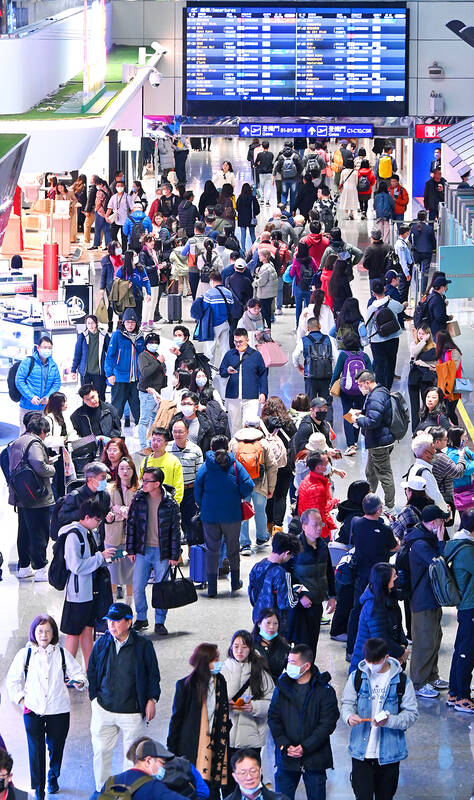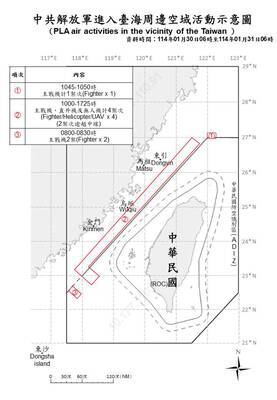The government is considering allowing visa-free entry to transit passengers and granting landing visas to tourists from Southeast Asian countries to attract more international visitors, Vice Premier Cheng Wen-tsan (鄭文燦) said yesterday.
“The nation has about 5 [million] to 6 million transit passengers per year. We will soon finalize how long they can enter Taiwan without a tourist visa. The goal is to make transit passengers an important source of international travelers,” Cheng told participants at a ceremony marking the annual Tourism Festival.
The government is also seeking to further streamline visa application procedures for tourists from Southeast Asian nations by granting them landing visas, provided that national security and other concerns are addressed, he said.

Photo: Liu Hsin-de, Taipei Times
The goal of attracting more Japanese and South Korean tourists to Taiwan remains unchanged, he said.
Visa application procedures vary for tourists entering from nations targeted by the New Southbound Policy, Bureau of Consular Affairs data showed.
Tourists from Australia and New Zealand are visa-exempt for 90 days, while visas for Malaysian and Singaporean tourists are waived for 30 days.
The government is conducting a 14-day visa-free trial for tourists from Brunei, Thailand and the Philippines. The trial is to end on July 31.
Tourists from Indonesia, Vietnam, Myanmar, Cambodia, Laos and India are subject to a dual-track visa application process. Individual travelers can apply for a three-month multiple-entry visa allowing them to stay for up to two weeks each time if they have within the past 10 years held visas issued by the US, the UK, the EU, Canada, Australia, New Zealand, Japan or South Korea, or they had had non-working visas from Taiwan and did not overstay their welcome without legitimate reasons.
Those joining high-quality group tours can use simplified visa application procedures for travel to Taiwan.
Statistics from Taiwan Taoyuan International Airport showed that 35.35 million air travelers accessed the nation’s largest airport last year, 6.25 million of whom were transit passengers.
The number of transit passengers rose 17.5 percent compared with 2019, a record high.
About 38 percent of them were from Southeast Asia.
Cheng also reiterated that the policy on resuming group tours to and from China remains unchanged, although its implementation had been interrupted by some “special events.”
“We hope that everything would soon return to the right track. Both the Mainland Affairs Council and the Ministry of Transportation and Communications have said that they are hoping for a show of goodwill from China by June 1. As long as things are going in the right direction, such as the easing of tensions across the Taiwan Strait or allowing Chinese tour groups to come [to Taiwan], the policy could always change before June 1,” Cheng said.
Minister of Transportation and Communications Wang Kwo-tsai (王國材) said that only goodwill could “turn things for the better.”
“We welcome Chinese tourists and support a healthy and orderly cross-strait tourism exchange,” Wang said. “The ball is in China’s court. What we are expecting is goodwill.”
The government is still committed to attracting 12 million international tourists per year, 2 million of whom would be from China, he said.
The Cabinet has budgeted NT$15.1 billion (US$479.08 million) to improve tourism infrastructure and NT$5.8 billion to promote cycling tourism, he said.
Tourists from Indonesia, Vietnam, Myanmar, Cambodia, Laos and India are subject to a dual-track visa application process. Individual travelers can apply for a three-month multiple-entry visa allowing them to stay for up to two weeks each time if they have within the past 10 years held visas issued by the US, the UK, the EU, Canada, Australia, New Zealand, Japan or South Korea, or they had had non-working visas from Taiwan and did not overstay their welcome without legitimate reasons.
Those joining high-quality group tours can use simplified visa application procedures for travel to Taiwan.

UNITED: The premier said Trump’s tariff comments provided a great opportunity for the private and public sectors to come together to maintain the nation’s chip advantage The government is considering ways to assist the nation’s semiconductor industry or hosting collaborative projects with the private sector after US President Donald Trump threatened to impose a 100 percent tariff on chips exported to the US, Premier Cho Jung-tai (卓榮泰) said yesterday. Trump on Monday told Republican members of the US Congress about plans to impose sweeping tariffs on semiconductors, steel, aluminum, copper and pharmaceuticals “in the very near future.” “It’s time for the United States to return to the system that made us richer and more powerful than ever before,” Trump said at the Republican Issues Conference in Miami, Florida. “They

GOLDEN OPPORTUNITY: Taiwan must capitalize on the shock waves DeepSeek has sent through US markets to show it is a tech partner of Washington, a researcher said China’s reported breakthrough in artificial intelligence (AI) would prompt the US to seek a stronger alliance with Taiwan and Japan to secure its technological superiority, a Taiwanese researcher said yesterday. The launch of low-cost AI model DeepSeek (深度求索) on Monday sent US tech stocks tumbling, with chipmaker Nvidia Corp losing 16 percent of its value and the NASDAQ falling 612.46 points, or 3.07 percent, to close at 19,341.84 points. On the same day, the Philadelphia Stock Exchange Semiconductor Sector index dropped 488.7 points, or 9.15 percent, to close at 4,853.24 points. The launch of the Chinese chatbot proves that a competitor can

TAIWAN DEFENSE: The initiative would involve integrating various systems in a fast-paced manner through the use of common software to obstruct a Chinese invasion The first tranche of the US Navy’s “Replicator” initiative aimed at obstructing a Chinese invasion of Taiwan would be ready by August, a US Naval Institute (USNI) News report on Tuesday said. The initiative is part of a larger defense strategy for Taiwan, and would involve launching thousands of uncrewed submarines, surface vessels and aerial vehicles around Taiwan to buy the nation and its partners time to assemble a response. The plan was first made public by the Washington Post in June last year, when it cited comments by US Indo-Pacific Commander Admiral Samuel Paparo on the sidelines of the Shangri-La Dialogue

MARITIME SECURITY: Of the 52 vessels, 15 were rated a ‘threat’ for various reasons, including the amount of time they spent loitering near subsea cables, the CGA said Taiwan has identified 52 “suspicious” Chinese-owned ships flying flags of convenience that require close monitoring if detected near the nation, the Coast Guard Administration (CGA) said yesterday, as the nation seeks to protect its subsea telecoms cables. The stricter regime comes after a Cameroon-flagged vessel was briefly detained by the CGA earlier this month on suspicion of damaging an international cable northeast of Taiwan. The vessel is owned by a Hong Kong-registered company with a Chinese address given for its only listed director, the CGA said previously. Taiwan fears China could sever its communication links as part of an attempt